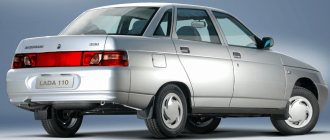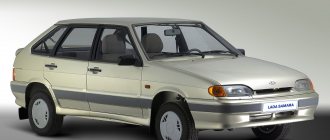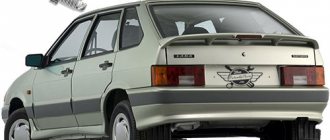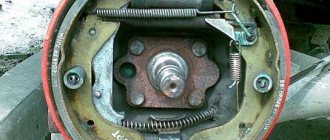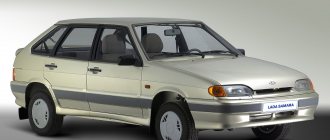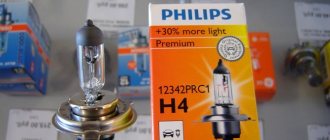Despite the fact that the body of the V8 is quite strong, you can’t drive it like a racing car, so I decided to weld the frame (note - a regular car means four-wheel drive, a frame and two axles).
One of the disadvantages of the 2108 body is its weakness in relation to the front wheels hitting a convexity such as a curb or a large stone. This usually breaks the crab.
If you install a good crab, it pulls out its fastenings. If you weld 12 nuts instead of 10 nuts, then the strength of the spars is no longer enough.
We lifted our VAZ 2108 on a lift and looked at the side members and levers for a long time, wondering how/what/where to hook it up. The main thing we were interested in was what materials would be needed and how much.
We counted and bought 18 meters of rectangular iron pipes with a wall width of 3 millimeters, 80×40, 50×50 and 60×30, 6 meters each.
Looking ahead, I’ll say that it turned out that 80x40 pipes won’t fit in a lot. It was necessary to take 70x40mm. In other words, 80mm will fit into the remains of the old spars, but with difficulty, more work to bend them. And in the end it turns out that if we made pipes out of 70 millimeters, the rigidity would be higher than that. But it's too late to change. The pipes have already been purchased and delivered.
We started with the wheel arches, cutting off the side members almost completely. Only the internal parts (right and left) of the main side members and part of the mudguard tins were left. In fact, the remaining parts of the side members will serve as mudguards. Later, everything was measured and a mock-up was made from cardboard, then adjusted on site.
Later, a piece of pipe (80x40x3mm) was bent according to this layout. Applied to the old box and refined.
Then these two pieces were welded into one and fitted together. Then it was boiled clean and the seams were cleaned. Two curved pipes came out.
In the area of the driver's and passenger's feet, where the outer part of the old spar had already been cut off, the inner part was cut along the upper corner and the vertical part of the box was bent with a sledgehammer into the body. To the tin of the floor and a little further, slightly pressing the iron.
Next, pieces of 60×30 pipes were hammered into the thresholds. Short ones - somewhere up to half a meter. These pipes will be tied to those arched 80x40 spars.
And from below (although they are driven inward into the threshold, the lower side of the thresholds is cut off to their length), pipes will be welded to them overlapping, which will go back to the rear suspension beam.
Next, to those curved 80x40 spars, they welded jib from a 60x30 pipe to the crabs, as can be seen in the photo. More precisely, up to the 5-millimeter-thick corner onto which the crab is screwed. And this was all connected to the front ends of the curved pipes with small vertical pieces of 80x40 pipe.
After this, these elements were completely welded. At the same time, we slightly strengthened the seams on the transverse arm mounts. When all this was boiled, it was necessary to constantly watch to ensure that nothing in the cabin or under the hood puffed up from contact with the heated iron. I also had to tinker with the wiring so as not to get caught. The engine was not pulled out. Just all sorts of little things, like the battery and tanks.
The rear parts are well tied to the pipes that are driven into the sills. Before this, they were slightly adjusted to be horizontal.
Later, we welded 60x30 pipes from the bottom and tied them to the pipes that were driven into the thresholds. In other words, long longitudinal pipes approximately from the rear arches to the front platforms for the jack.
They decided not to touch the rear platforms for the jack. They simply cut holes in the pipes for them, but the strength of these pipes was still greater.
The front edges of these long pipes were made inclined (so as not to stick them into stumps) and welded, and cut off at the back.
They temporarily refused to attach the front suspension cups to this frame. We thought about running a 60×30 pipe up next to (closely) with the A-pillar. We ran the channel along the outside of the mudguard forward to the front edge of the glass. After that, I went obliquely forward - downwards, bypassing the platform, which is under the battery on the left, and under the washer barrel on the right.
It seems like going around a circle around the front suspension strut. But they didn’t figure out how to attach the wings after that. They are screwed from the rear to the body pillar. This place needs to be completely remodeled. Overall, we decided not to touch it for now.
Everything welded was covered with anticorrosive. The floor in the cabin was cleaned as much as possible and almost two cans of aerosol bitumen mastic were poured onto it. I wanted to put insulation there, but for some reason I couldn’t find it in stores. I left it like that. Once I buy the insulation, I’ll pour another can onto the floor and put the insulation on the bitumen.
Then I spent half a day assembling the interior and screwing on the wings. It turned out that one person is quite capable of hanging the bumper. Even without a lift.
In general, the process is completed or paused.
As a result of installing the frame, the car became heavier by about 50..60 kilograms. It didn’t seem to have much of an effect on the dynamics; it didn’t accelerate slower.
The center of gravity has dropped a little - the frame is all at the bottom. Also, the center of gravity has moved a little forward. But I didn't feel it.
The torsional rigidity of the body has increased slightly. Now the trunk door does not warp so much when parking with one wheel on the curb. But still, I want more rigidity. I will weld a cross from pipes behind the back of the rear seat.
How does the engine warm up?
Each serviceable unit has a different warm-up time. It is influenced by:
- degree of forcing;
- engine type: diesel or gasoline;
- cooling system condition;
- stove operation;
- quality of antifreeze or antifreeze;
- work load;
- outside air temperature;
- type and viscosity of engine oil.
The characteristics of the oil are rarely taken into account, but experts believe that this is necessary. Various friction reducing additives and the base stock, synthetic or semi-synthetic, affect the performance in the range of 5–7 degrees. Thus, the engine will heat up faster with thinner synthetic oil.
The engine temperature gauge does not rise often due to a malfunction of the thermostat. It is with this unit that the system check always begins if the engine takes a long time to warm up to operating temperature.
Spacers as a means of increasing ground clearance
Some support kits (for example, SS-20) have so-called “spacers” (12mm). They are installed between the strut support and the car body and are divided into polyurethane, aluminum and plastic. I think the positive effect is clear - higher ground clearance, but the negative effects will be different:
- In the first case, on uneven roads the polyurethane contracts and the bushings deform the car body.
- In the second, ride comfort is not reduced, and the body is not deformed, but they provoke corrosion processes on roads with a sand-salt mixture.
- In the case of plastic, no negative impacts have been identified.
Shock absorbers and ground clearance, where is the truth?
When the car is standing still, the shock absorbers will not lift the body - after all, it hangs on springs. The role of the struts can be understood in motion, when the car sways and “pecks” on soft or dead shock absorbers. You drive off the curb and your car’s nose hits the asphalt! If the shock absorbers are in good condition, they will “catch” the car halfway. Thus, shock absorbers do not affect ground clearance, but have the same effect as increased ground clearance.
Alternative shock absorbers may have a longer rod, which will provide more suspension travel. We discuss these subtleties in the topic “which shock absorbers are better to choose.”
Principle of operation
Coolant enters the radiator through the thermostat. This is a large circle of fluid circulation. The thermostat usually opens at a temperature of 100 degrees Celsius. If the temperature has not reached this limit, then the liquid moves in a small circle. A thermostat malfunction is manifested by improper opening of the valves.
When the thermostat is closed, the engine overheats, and a constantly open one leads to low temperatures, since the liquid will only flow in a large circle.
Due to irregular changes of antifreeze or antifreeze, use of running water or mixing of coolants, various deposits in the form of scale may accumulate in the system. In this case, the thermostat will inevitably jam in one of its positions.
Selection of new
Look at different photos to see what the assembled rear pillar for a VAZ 2114 looks like. This will allow you to understand what you generally need to look for for this car.
The fourteenth model of the domestic automaker AvtoVAZ provides for the use of a telescopic rear pillar.
Kayaba kit
We will not rant about which ones to buy, with what characteristics, from what materials, and so on. We will simply offer you objectively the three best options.
| Name | Advantages | Flaws |
| SS20 | A high quality device that will provide excellent performance characteristics to the car. | When replacing, you need to additionally purchase a support from the same company. |
| Plaza | Available in three types - Sport, Comfort and Supersport, they have excellent performance characteristics. | Not frost-resistant, therefore problems may arise when used in winter |
| KYB | Available in several types of execution, depending on the driver’s style, they are distinguished by the best characteristics | High cost and widespread counterfeits due to the popularity of racks. |
Checking the Thermostat
To diagnose the malfunction, you should contact a service specialist. However, you can check the thermostat yourself. The cold engine is allowed to idle for approximately 10 minutes. After this, you need to check the radiator pipes. If the thermostat is functioning properly, the hoses will not become hot. The temperature rises only at the moment when the coolant begins to circulate in a large circle.
The coolant enters the large circle only after reaching operating temperature. If the pipes begin to heat up before the specified point, you should immediately contact a technician for further diagnosis and troubleshooting. There are also more professional diagnostic methods using special sensors. Such a check can be carried out at a service station.
If the device does not open and close completely, partial overheating may occur or the temperature will rise, but very slowly. Also, the wedge can be observed only periodically.
Any specified defect requires careful examination and repair. If you do not have the necessary skills and minimal knowledge about the internal structure of a car, you should contact qualified car service specialists.
To remove the thermostat, you must first get rid of the liquid in the system. It is important to wait until the entire system has cooled down before replacing the part. Removing the thermostat is quite simple; to do this, just unscrew the three bolts located on the cover and remove it together with the thermostat.
Taking into account all the design features of this model, it can be replaced with an identical or suitable analogue. Well-known brands produce units that can be interchanged, so there are no difficulties with selection. In any case, all manipulations must be carried out by a person who knows exactly what needs to be done, takes into account the make, year of manufacture, and mileage of the car.
It is very important to consider that the cost of this part is quite low, so it would be more appropriate to replace it than to repair it. Thus, you can get rid of problems with low engine temperature for the entire winter season.
Since when replacing the thermostat you will have to drain the fluid, it is worth checking the engine for performance before the start of the winter season. Many car owners pour antifreeze into the system and then face the need to replace the unit, therefore paying twice for the coolant.
Negative consequences of increasing clearance
If the vehicle's ground clearance is increased by no more than 5cm, then there should be no negative effects. But a further increase in clearance will be associated with unjustified difficulties. In addition to those points described above, add less stability of the car on the road (drift and large rolls) and greater wear of suspension components and assemblies. What does it mean ?
When the center of gravity rises, the car's roll and sway increase while driving. To prevent a rollover, it is important that the vehicle's suspension is adjusted correctly. An example would be a tall Mercedes A class when it capsized in front of journalists during the “moose test”. Then they delayed the release of the car and began to modify the chassis. It all ended with increasing the elasticity of the suspension and replacing the wheels with low-profile ones. You can combat vehicle roll by installing various additional stabilizers.
Other reasons
A malfunctioning thermostat may not be the only reason why the engine does not reach operating temperature.
If the pipes were not tightened well during the previous repair, the car owner is faced with air leaks. Coolant begins to leak. If this is the problem, then you should tighten the clamps for a tighter fit of the tubes and add fluid to the required level in the expansion tank.
In this case, the car owner will see a low temperature on the dashboard, which is insufficient for operation. In fact, the engine will overheat and may even boil.
A faulty temperature sensor can cause the engine to feel like it takes a long time to warm up or may not heat up at all. In this case, the engine works properly. The sensor transmits temperature status data to the dashboard. If it does not work correctly, then the readings will be incorrect. Replacing this part will bring all indicators back to normal.
The problem with the sensor is quite serious on modern cars equipped with electronics. Here again you will have to deal with supplying an over-enriched mixture and replacing many other parts.
Any problem that arises must be resolved with the help of a competent specialist. If you do not have the necessary knowledge and skills, you should contact a car service center. Experienced technicians will help eliminate the problem and prevent its occurrence in the future.
The problem of engine overheating is well known to many owners of domestic cars. The VAZ 2110 (2111, 2112) and 2113 (2114, 2115) lines were equipped with small-volume cooling radiators, so when driving for a long time in hot summer weather, the VAZ “normally” heats up to 105-108 degrees. But if the temperature goes through the roof even after a short trip, this is a reason to think about problems with the cooling system.
A high operating temperature of the engine may also indicate serious malfunctions. But in most cases, the VAZ 2114 heats up for minor reasons, including:
- thermostat malfunction;
- malfunction of the coolant temperature sensor (DTOZH);
- malfunction of the high pressure valve in the coolant tank cap;
- clogged radiator.
Install houses on the rear suspension of the car
We approached the issue of installing spacers (houses) between the lower end of the rear shock absorber and the eyes of the rear suspension beam of the VAZ 2110. The convenience of this method of raising the car is that the houses, due to special holes, allow you to choose the height of the increase in ground clearance.
There are a lot of disputes about the advisability of installing “houses”; some claim that this is a good way to raise the rear if the springs have sagged, others cite a number of negative statements. Only one thing is clear: if you decide to install shock absorber spacers, then do not forget that three important parameters will change along with this:
- position of the brake force regulator (“sorcerer”);
- headlight adjustment;
- the longitudinal inclination angle of the steering axis of the front wheels (caster).
These parameters are directly related to the safety of the car on the road, so it is important not to forget to adjust them.
Thermostat malfunction
The thermostat is one of the weak points of the VAZ. It can be found on the right side of the cylinder block when facing the vehicle. To check the thermostat, you need to warm up the car until the fan turns on and touch the lower radiator hose with your hand. If the thermostat is working properly, it should be warm.
Removing the thermostat on a VAZ 2114
A cold pipe indicates that the thermostat is stuck in the closed position. In this case, the coolant circulates around the radiator, in a small circle. Heat exchange is disrupted - the engine quickly overheats. The problem is solved by replacing the thermostat.
Correspondence of spring markings to the model
When installing springs on a VAZ suspension, it is advisable to ensure their compliance.
- 2101 install on rear-wheel drive sedans.
- 21012 is tougher, made from a larger diameter rod. Installed on a VAZ with left-hand drive, with special equipment, when a front suspension with increased energy intensity is needed.
- 2102 are installed on station wagons VAZ-2102, 21014. Their length is increased by 21 mm compared to 2101, so they are installed on sedans only when you often have to drive on country roads so as not to hit bumps - when installing 2102, the ground clearance under body They cannot be used to increase the load capacity, since they inevitably lead to premature destruction of the body.
- 2108 is installed on all front-wheel drive models, except for modifications with a 16-valve engine and Oka. By the way, in the markets they often deceive owners of VAZ-21099 sedans by offering to purchase scarce “99 springs”. In fact, there are ordinary “eighths” there, and “99ths” do not exist at all.
- 2110 European ones are installed on the rear suspensions of VAZ 21102-21104, 2112, 2114, on the front and rear suspensions 21122 and 21124. The European version is created for cars intended for export. The ground clearance here is reduced by 20 mm, the compliance of the springs is reduced in order to increase their stability at high speed when turning. The cross-country ability of vehicles on off-road and dirt roads is significantly deteriorated.
- 2111 are installed on the rear suspensions of VAZ 2111 and 2113.
- 2112 are installed on the front suspensions of VAZ 21103, 2112, 21113.
- 2121 is used on all-wheel drive models, except Oka.
Radiator clogged
The radiator can be clogged from the outside and inside. External contamination is associated with dust and other debris, as well as insects, entering the honeycombs. This worsens heat transfer and is manifested by frequent operation of the fan and a long operating time.
Clogged engine radiator honeycomb
A good high pressure washer solves the problem. If the radiator has been in use for a long time, the car cools and heats up worse due to deformation of the honeycombs. You can “cure” this problem by replacing the radiator.
The radiator rarely clogs from the inside. This usually occurs due to poor quality antifreeze, driving on water, or as a “side effect” of radiator sealants. The presence of this problem is indicated by the coolant: it becomes cloudy, oil stains and solid particles are visible in it. Flushing the cooling system of the VAZ 2114 is carried out by completely draining the antifreeze with distilled water with the addition of radiator cleaning agents.
Properties of suspension springs
When torsion bars on vehicles were replaced with springs, handling improved and suspensions became more convenient to maintain. Springs maintain the vehicle's ground clearance, reducing vibrations and shocks while the vehicle is moving.
To make the ride comfortable, you need to choose the right parts. If the technical characteristics are unsuitable, then the positive properties of the suspension will be reduced to zero
Therefore, it is important to consider the following parameters:
- diameter - its increase affects rigidity;
- number of turns - as the number increases, the rigidity decreases;
- form.
When to change springs.
Often, car owners strive to install stiffer parts in the suspension. This helps to increase the sensitivity of the steering wheel to the driver's control, but the grip on the road deteriorates. Dimensions, volumes and features of trunks for VAZ 2113, 2114 and 2115
Fans of a sporty driving style believe that, on the contrary, it is better to install parts with reduced rigidity. However, this suspension can create problems on country roads.
Let's take a closer look at which springs are best installed on a VAZ.
Dashboard malfunction
The cause of incorrect readings on the dashboard may be a factory defect or a huge number of electrical faults: from a bad ground on the ECU to a failure of the voltage stabilizer (“tablet”). This can be indicated by uneven changes in temperature readings (jumps), incorrect readings of other devices, or a discrepancy between turning on the fan and the temperature readings.
This malfunction is less problematic: the car does not actually heat up, but only for the computer. But she discovers other problems that also need to be solved.
Class “A” and “B” - are the differences significant?
For many car enthusiasts, spring stiffness by color is equivalent to stiffness by class. Class “A”, regardless of color, is more stringent than class “B”. In fact, this is not an entirely true statement. Class “A” is really more suitable for cars that are often used under high load. But the difference here is quite small - about 25 kg. Despite the mandatory application of markings, there are still samples on which it is absent. In this case, even if the color coding of the elements is identical, it is better to refuse to purchase and use them.
Many motorists underestimate the importance of high-quality springs, especially during intensive use of the car. It’s not for nothing that the springs are marked by color - this makes it much easier for a novice driver who is replacing this element with his own hands for the first time. Purchasing products of appropriate quality, albeit at a higher price, will inevitably pay off with a softer ride, less wear and tear on the car, and less stress on the driver himself. It has been scientifically proven that high vibration loads on a person lead to rapid fatigue and decreased concentration when moving.
Pump malfunction
The pump rarely fails completely, so the fault can be accurately diagnosed only after removal. The most common problem with it is the impeller breaking off. It can be solved by replacing the pump. Other troubles include deformation of the pump gear and blades due to defects or mechanical wear. This fault is especially serious as it can cause the timing belt to become misaligned. And this is its uneven wear and the danger of breakage with all the sad consequences for the piston group.
Leaking cylinder head gasket
This problem is one of the rarest causes of engine overheating in VAZ 2114 cars. When it occurs, overheating is a secondary symptom that may be accompanied by a number of others:
- oil leaks from under the cylinder head;
- uneven engine operation and low compression;
- increased oil consumption, noisy engine operation and gas flow, black exhaust.
In this situation, at best, the solution would be to replace the cylinder head gasket. At worst, a major overhaul of the engine with cleaning of all internal cooling channels.
When the engine gets hot, it is dangerous not in itself, but because of its consequences. Long-term driving at elevated operating temperatures first leads to loss of properties of elastic parts: valve stem seals and piston rings. Because of this, oil consumption increases, and engine operation becomes uneven and dirty. All this leads to expensive major repairs.
The consequences of severe overheating are even more severe: the cylinder head and cylinder block are deformed and sometimes crack. An engine that has survived this can no longer be repaired.
A cold lower radiator pipe after heating the engine of a VAZ 2110, 2114, 2115 indicates a violation in the vehicle’s cooling system. If proper operation is not restored, the engine will overheat, leading to engine failure. There are several reasons that cause improper functioning of the cooling system of a VAZ 2114, 2115, 2110 car. And even experienced motorists cannot always figure out why the lower radiator pipe of the car remains cold.
Interturn spacers in springs, for what?
Undoubtedly, the interturn spacer allows you to increase ground clearance to some extent. This happens by reducing the compression of the spring. After installing such spacers, the car will no longer have the same rocking motion and the car will stop pecking at the front end. In addition, interturn spacers can protect the suspension from puncture, but they lead to a decrease in the shock absorber's compression stroke (the shock absorber practically does not work, the spring practically does not compress), an increase in suspension rigidity, and a decrease in comfort.
The design of the VAZ 2110 cooling system
The main function of the cooling system is to maintain the engine operating temperature at 98-103°C. When the engine is running, the heat of the working parts is removed using coolant that constantly circulates in the system. While the engine is heating up, antifreeze or antifreeze moves in a small circle without passing through the radiator. The thermostat is closed at this time.
When the operating temperature is reached, the thermostat opens and the liquid circulates in a large circle. Both pipes become hot. The radiator promotes greater cooling by air flow. The fan increases the cooling intensity. The pump ensures continuous circulation. The thermostat regulates the amount of fluid supplied to the system.
For efficient operation of the VAZ 2114, 2115, 2110 engine, various indicators are taken into account:
- oil temperature;
- coolant temperature;
- outside temperature, etc.
The functioning of the cooling system is controlled by the engine management system, which collects all specified parameters.
A cold lower radiator pipe on VAZ 2110, 2114, 2115 does not always indicate a problem in the system. With a cold engine, before the large circle opens, it should not heat up, since hot fluid does not flow to the radiator. The thermostat can block circulation in a large circle in the cold season, when hot air from the coolant enters the car interior, causing it to cool faster. You need to pay attention to the cooling system if the radiator pipes remain cold when the internal combustion engine reaches operating temperature and it overheats.
To check the efficiency of the system in cold weather, it is recommended to drive the VAZ 2110, 2114, 2115 into the garage, let the engine warm up with the cabin heater closed for 10-20 minutes, and only then draw conclusions. If even under these conditions the pipe is cold, you need to look for the problem.
Lowering VAZ 2114
Lowering of VAZ 2114 front -50, rear -70 mm. Apparently it won't be short. Probably 70-80% of 2108-2114 owners have thoughts of lowering the car. I also wanted the car to look better, but not to shake. Understating the BPAN is still not my thing, especially since there is a need to drive not only around the city.
It became
The situation was complicated by the fact that I had no experience in working with/changing the suspension.
For a whole year I thought and decided what and how to do. Just sawing is not my thing, I drove such cars, not very well. As a result, I found a person who has sufficient experience to advise me on a worthwhile understatement. And I brought life together with this man. So, I explained to him what and how I wanted in the end. He proposed a compromise option: lowering -50/-70, and then, he said, this is close and even a lot for the suspension to work well. Deep down I disagreed because... I wanted either -70 around, or -70/-90, but I listened to him, because... I have a lot of experience, but I am guided 80-90% by emotion and desire for appearance. Among other things, he had contacts in Togliatti at Demfi, the opportunity to order racks specifically for springs from the local Kulibin and assemble them manually. So, we decided together (he advised, and I wisely agreed): 1)
Demfi Premium struts, manual lowering -50/-70
2)
Evolex supports
3)
Springs I bought earlier - Tehnoressor -50/-70
4)
SS20 bump stops Struts and the supports arrived from Togliatti in about a month and a half, bought additional boots and bumpers, and went to install them (also on recommendation). After installation, I went to the breakdown. The result is that it has become tougher, but not critical. The car does not chatter, does not shake, the suspension works as it should. I also sometimes travel as a passenger in a Note, Teana, Passat CC, Corolla - of course, it cannot be compared with the softness, but these are other cars. Moreover, there was a contrast, because On the day of changing the suspension, I changed the winter R-14 to the summer R-15. The car has become more stable in turns; I can consistently take the same turns in a higher gear. The only “BUT” is that it was just a little short of the lowering that I wanted. Ideally, it would be even lower by -40/-20 mm, I think this would not affect pragmatism (I wouldn’t start scraping the asphalt with my belly), but it would look very cool. If this desire does not go away further, I will think about something.
Was
It became
When I first bought the car, it had spacers on the back for the rear shock absorbers. But it didn’t bother me then. Then I wanted to lower it, a year later I did it, I lowered it primarily so that the car would steer, I didn’t want to spend 15 thousand on short-stroke struts and springs (as well as 15 thousand themselves)), so I cut 2 by 2 turns, but the back turned out to be high, and then another turn at the back, for a total of 2 by 3.
I really liked the way the car behaved; you could take corners, it still stood as if on rails, and at the same time you didn’t have to worry about the ground clearance, it was enough to drive everywhere without any problems, just like on stock.
But the struts were damaged, and after about 5 months the car began to rock on bumps, and on potholes, due to the short stroke, the suspension was punched, and all these blows go wherever you think, right, on the body and on your back, the panel keeps rattling, the radio I failed once, and the hard blows to the back made me sick. And by winter the landing was over, I bought new standard struts and springs.
I immediately began to notice that there was a lack of controllability, and I’ll tell you why now. The fact that the center of gravity is high is already understandable, but the main bullshit is that the ass is higher than the front, plus the entire mass of the car in front, it turns out that the front is overloaded, and when you go into a turn, the car leans on the front wheel on the outer side of the turn and the ass in the back dangles slightly when there's shit in the hole, there's no grip. The castor also turns out to be small or even negative. Also, there is no comfort, again due to incorrect weight distribution. Well, now the main thing is how to solve this problem. Well, yes, lower your ass. 2 turns will be just right. It’s better not to touch the front because the suspension travel decreases, and with it comfort and ground clearance, which is necessary to leave the yard in winter, or when driving on a snow-covered road on which an obstacle may arise in the middle of the road that will not be possible to get around; such situations have happened to me, In general, lowering the front will only worsen the properties of the car.
By lowering the rear, we get advantages in the form of better weight distribution, and this is always very much appreciated in cars. Now the ass is more confident in turns, there is no roll on the front wheel, the load is distributed more evenly between the front and rear. Comfort has increased, again due to weight distribution, because the front wheels are not overloaded. The castor has increased, which means the car turns better and easier, and also drives straight when accelerating, rather than throwing it in all directions as before. The car tilted back and even sitting in the chair became more comfortable. Regarding the transportation of bags of potatoes and other things, don’t worry, nothing will be rubbed. That’s actually all that I planned to talk about on this topic, I was convinced from my own experience that this understatement is the best solution and comfortable for everyday use.
© 2016-2021 24techno-guide.ru
All rights reserved.
Use of site materials is possible only if you install an active direct link to our resource. FEEDBACK
Home
(Main page of the site)
Auto
(Reviews, reviews, test drives of cars)
Engines
(Description and design of various engines)
Techno
(Articles about equipment and mechanics)
Tuning
(Review of tuned cars)
Repair
(Do-it-yourself repairs)
Tractors
(Tractor special equipment)
Osago
(All about car insurance)
Car audio
(Music for the car)
Car LAWS
(Traffic rules, fines and car laws)
Lifehacks
(Tricks of life)
Photo/Video
(No comments)
All articles
(All publications that are on the site)
Removing the air lock
Signs of the formation of an air lock in the cooling system are rapid warming up of the car to high temperatures and poor performance of the interior heater. This can be especially easy to notice in winter. The reasons for the appearance of an air lock are different:
- incorrect filling of coolant;
- engine overheating;
- depressurization of the system;
- damage to some parts, etc.
If, during the inspection, leakage of antifreeze (antifreeze) is detected in the system, traces of coolant on the engine or other places, the causes of the leak should be eliminated. Often depressurization occurs due to poor tightening of clamps on pipes and hoses. They need to be tightened up. Any deformed or faulty parts found should be replaced.
There are several ways to remove air pockets. The easiest one is to drive up a steep hill with your face up. Unscrew the radiator and expansion tank caps. Let the car warm up for 10-15 minutes. Then release the gas a little and fill the system with coolant to the required level. Continue until bubbles stop appearing.
In VAZ 2110, 2114, 2115 cars, airing is rare. The cause of similar symptoms may be clogged hoses or radiator.
Strengthening and modernization
Strengthening or tuning the body of a VAZ 2109 according to the instructions should be carried out only if the owner is well versed in the design features of the car, has an appropriate understanding of the device, and knows the technical data on weight and other parameters. Otherwise, it is better to entrust the modernization work to professionals at the service station. True, the price of their services in these matters is too high, but you will be satisfied with the result.
So, tuning a VAZ 2109 car is, first of all, upgrading its body. The process always begins with this, and only after that the power unit and other components of the machine are brought to the desired state.
Cleaning or replacing the radiator
The radiator, located in the front of the car, absorbs the main flow of dust and dirt. For its effective operation, timely prevention and cleaning is necessary. The radiator can become dirty both inside and outside.
An indicator of internal cleanliness is the condition of the coolant. Manufacturers recommend changing antifreeze every 75,000 km or every 5 years. However, a change in the color of the liquid, severe darkening, discoloration, or the presence of rust requires urgent replacement of the coolant. It is recommended to change antifreeze at least every 40,000 km.
To carry out internal cleaning of the cooling system of VAZ 2110, 2114, 2115, it is necessary to drain the liquid. Sequencing:
- open the expansion tank cap;
- place a container to drain the antifreeze;
- Unscrew the drain plug from the cylinder block;
- drain the refrigerant;
- unscrew the radiator drain plug (located at the lowest point);
- drain the remaining antifreeze (antifreeze);
- tighten all the plugs.
To clean, pour distilled water into the system and start the engine for about 20 minutes. Ordinary water contains many impurities and forms scale, so its use is undesirable. The liquid is drained several times until clean water flows out. This method is ineffective as it removes a small amount of deposits.
For more effective washing, it is advisable to use special chemical additives. The detergent components included in their composition allow you to dissolve deposits and remove various types of contaminants. The mixture of water and vinegar used by many motorists is less effective. It does not remove all deposits. After using chemicals, the cooling system is washed with distillate.
After cleaning the entire SOD of the VAZ 2110, 2114, 2115, an additional internal flushing of the radiator is carried out. To do this, you need to detach the hoses from the base and the upper and upper tank. Liquid is poured into the radiator through the upper pipe using a garden hose. Flushing is carried out until clean water flows from the lower pipe.
The removed radiator can be externally cleaned to remove dirt, insects, and sand from the cooler honeycomb. Cleaning is carried out with a soap solution or special devices that create a strong flow of water or air, for example a Karcher vacuum cleaner. The procedure should be carried out carefully so as not to bend the radiator honeycombs.
If damaged or heavily soiled, the radiator should be replaced.
Replacing the thermostat
If the thermostat valve does not operate correctly, the coolant does not circulate throughout the large circle of the ODS. The lower pipe remains cold even after the refrigerant is heated to 90°C. The top pipe may be hot due to steam escaping. The thermostat can also get stuck in the open position; in this case, the engine does not warm up to the required temperature or takes too long to warm up.
In preparation for replacing the device, it is necessary to drain the fluid from the system and remove the air filter. Then the radiator and fluid pump hoses are disconnected from the thermostat housing. After this, loosen the mounting bolts and remove the thermostat cover. The device is replaced with a working one. Attaching the thermostat is done in the reverse order.
These are the main reasons for the malfunction of the cooling system and the cold lower pipe of VAZ 2110, 2114, 2115 cars.
How to raise the front of a VAZ 2115
- Registration
- Entrance
- To the beginning of the forum
- Forum Rules
- Old design
- FAQ
- Search
- Users
Am VAZ-2115, 1 year. Mileage: approx. 45,000 km. Settles on the rear axle under load. Shock absorbers and springs seem to be normal. Should I install spacers? If placed, in what position? Will the car start to “goat”? In general, what are the pros and cons of spacers?
My car is not 3.5 years old, I haven’t had one and I don’t intend to install them and I don’t recommend them to others. Stability decreases, controllability deteriorates, tire wear and rubber increases. blocks, grenades, rear and, as a result, front pads (the rear brakes worse) - in short, apart from the ground clearance, there are only disadvantages

